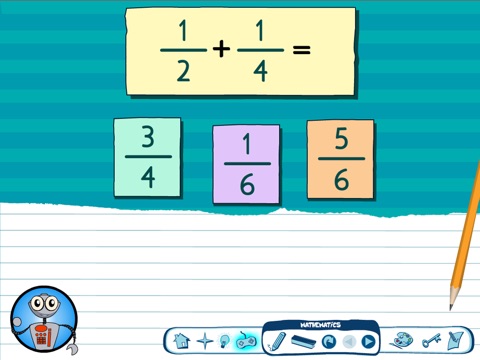
Adding Unlike Fractions app for iPhone and iPad
Developer: Electrokite Interactive
First release : 13 Jun 2012
App size: 19.1 Mb
Now updated for iOS8 and iOS9.
Learn how to add unlike fractions with this Common Core standards aligned app! Tested in classrooms and highly effective. Great for the classroom.
Students will learn to:
• Recognize unlike fraction equations
• Find the least common denominator
• Convert and add numerators
• Reduce fractions
• Add unlike fractions
Grade Level(s)
4 5
Common Core Standards
4.NF.1 Explain why a fraction a/b is equivalent to a fraction (n * a)/(n * b) by using visual fraction models, with attention to how the number and size of the parts differ even though the two fractions themselves are the same size. Use this principle to recognize and generate equivalent fractions.
4.NF.2 Compare two fractions with different numerators and different denominators, e.g., by creating common denominators or numerators, or by comparing to a benchmark fraction such as 1/2. Recognize that comparisons are valid only when the two fractions refer to the same whole. Record the results of comparisons with symbols >, =, or <, and justify the conclusions, e.g., by using a visual fraction model.
5.NF.1 Add and subtract fractions with unlike denominators (including mixed numbers) by replacing given fractions with equivalent fractions in such a way as to produce an equivalent sum or difference of fractions with like denominators. For example, 2/3 + 5/4 = 8/12 + 15/12 = 23/12. (In general, a/b + c/d = (ad + bc)/bd.)
5.NF.2 Solve word problems involving addition and subtraction of fractions referring to the same whole, including cases of unlike denominators, e.g., by using visual fraction models or equations to represent the problem. Use benchmark fractions and number sense of fractions to estimate mentally and assess the reasonableness of answers. For example, recognize an incorrect result 2/5 + 1/2 = 3/7, by observing that 3/7 < 1/2.



